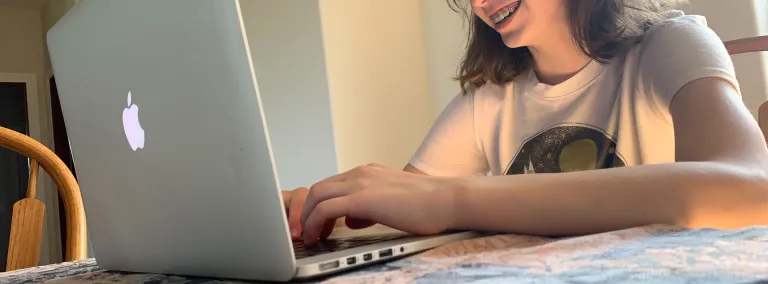E&O team continues to support SD educators through online programming
Education and Outreach team develops online educational resources as COVID-19 concerns keep schools closed
Typically, spring semesters are a busy time for the Sanford Underground Research Facility’s (Sanford Lab) Education and Outreach team (E&O). From hosting field trips, giving school presentations and piloting new curriculum modules, the team has been actively supporting regional educators since 2007. This spring, however, the E&O team has made drastic adjustments as educators across the state transition their classrooms online.
In mid-March, South Dakota Governor Kristi Noem mandated that all K-12 schools remain closed until further notice in an attempt to slow the spread of COVID-19. Since then, teachers across the state have been tasked with converting months of lesson plans into online formats to continue teaching their students from home.
Deb Wolf, director of E&O at Sanford Lab, said the online switch is not an easy adjustment.
“This is not ‘online learning,’” Wolf said. “The term ‘online learning’ presupposes there was time to plan and develop an online course. What teachers are undertaking right now might be more aptly referred to as ‘emergency remote learning.’”
At Sanford Lab, the E&O team is taking previously scheduled programs and adapting them to continue to support teachers throughout the state. Although the biggest hurdle has been working with unfamiliar technologies, the team is leveraging online video conferencing and educational platforms.
Presentations and field trips
Peggy Norris, deputy director of E&O, has been working with educators at Spearfish Middle School to provide a weekly online science presentation open to all eighth-grade students.
During the first lesson, students took a survey to see how their current hobbies and interests could one day translate into a career in science. The following week, two Sanford Lab engineers spoke with more than 30 Spearfish eighth graders about working on the LUX-ZEPLIN dark matter experiment. In the next presentation, the students will learn about the evidence that supports dark matter and how microscopic life forms survive underground.
The team is also developing a virtual facility field trip through a video conferencing presentation.
Piloting new curriculum modules
In addition to field trips and presentations, the E&O team also offers 16 curriculum modules for regional educators. Each module includes all the tools a teacher needs for 10-20 hours of instruction and is aligned with South Dakota's K-12 Science Standards.
Becky Bundy, E&O science education specialist, recently created a curriculum module that focuses on the science of biofilms. The module was created as part of a South Dakota EPSCoR grant, which aims to advance the study of biofilms in the state and also spur the development of statewide science education and workforce development infrastructure.
Usually, the team will pilot new modules with students in a classroom before developing it further. With no active classrooms available, a team of student teachers from Dakota State University (DSU) stepped in to help test the module. During the pilot, the student teachers acted as both learners and educators, testing the material and providing feedback to Bundy.
“We wanted to leverage the knowledge of these student teachers to find out how the module worked,” Bundy said. “Did they notice all the dimensions of learning? Did it hit the standards that need to be taught?”
Teacher professional development programs
The team is also considering new approaches to two upcoming teacher professional development programs. The first is a week-long program that usually draws up to 60 South Dakota educators to Black Hills State University. The second, funded by the South Dakota EPSCoR grant, includes six multi-day programs at locations throughout South Dakota.
“We recognize that these summer professional development programs will likely need to look different,” Wolf said. “And we are beginning to plan for that.”
As they consider moving professional development programming online, the team stresses the importance of preserving the program’s ability to build professional relationships between participants.
“We pride ourselves on the relationships these teacher cohorts create as they learn from and with each other,” Wolf said. “We are looking for creative ways to maintain the integrity of authentic conversations in an online format.”
Growing through the challenge
In some ways, these unexpected challenges have pushed the team forward.
“We can't do our work the way we've always done it before,” Wolf said. “I feel like all of us are working at the edge of our abilities. That's not a bad thing, though, because that's where you grow.”
To educators in South Dakota, Wolf said, “If you were planning to do something with Sanford Lab this spring—a curriculum module, a field trip, a presentation—don't think that that is off the table. We are working with teachers across the state to support them in new ways.”
The Education and Outreach program is a collaborative venture between Sanford Underground Research Facility and Black Hills State University. Our goal is to use the excitement and promise of deep underground science and engineering to inspire and engage students, educators and the wider community through a variety of programming.
